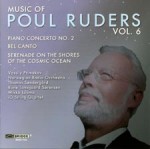Column Name
Title
Music of Poul Ruders, Vol. 6. Piano Concerto No. 2; Bel Canto; Serenade on the Shores of the Cosmic Ocean. Vassily Primakov, piano; Norwegian Radio Orchestra; Thomas Sondergard, conductor; Rune Tonsgaard Sorensen, violin; Mikko Luoma, accordion; IO String Quartet. Bridge 9336
Body
In the notes to this recording, Poul Ruders writes about his decision to “go for broke” composing a virtuosic vehicle for Juilliard alum Vassily Primakov (B.M. ’03, piano), and most listeners will agree that he has succeeded. Written in 2009-10 and commissioned by Jerome Lowenthal (Primakov’s teacher at the School) and the Norwegian Radio Orchestra (which performs it here with Primakov), the Piano Concerto No. 2 is a tightly knit, transparent example of the composer’s most recent eclectic style, containing a healthy dose of Neo-Classicism. Its dedicatee seems inspired by the music’s challenges and hurls himself into its intricacies. In three brief movements, there are occasional moments of quietude, but most of the time Primakov has his hands full with Ruders’s fiery score.
To cool things off, Bel Canto (2004) draws on the expertise of violinist Rune Tonsgaard Sorensen, whose lush tone takes its cue from the title’s meaning (“beautiful song”). Ruders has created an unaccompanied flight for solo violin, more lyrical and passionate than one might expect from the composer, who here (unlike in the Piano Concerto) eschews the temptation to write something that will make the soloist sweat.
The disc ends with Serenade on the Shores of the Cosmic Ocean (2004), nine short movements inspired by Carl Sagan’s book Cosmos. Listeners will be swept up immediately by the caustic, radiant timbres created by a string quartet with an accordion that is often pressed to its highest registers. One striking exception is the central “Backbone of the Night,” in which the accordion’s growling low passages provide contrast to the glassy upper tone of the strings. The Finnish virtuoso Mikko Luoma makes the taxing accordion role sound easy, as do the members of the IO Quartet—Christina McGann and Sara Crocker (B.M. ’07, M.M. ’09, violin and M.M. ’06, violin respectively); Elizabeth Weisser, viola; and Christopher Gross (M.M. ’06, cello)—with the string parts. The recording, culled from three sessions by multiple engineers in Norway, Denmark, and New York City, has been eloquently coordinated by veteran Adam Abeshouse.
Marcel Tyberg: Symphony No. 3, Piano Trio. Michael Ludwig, violin; Roman Mekinulov, cello; Ya-Fei Chuang, piano; Buffalo Philharmonic Orchestra, JoAnn Falletta, conductor. Naxos 8.572236.
Austrian composer Marcel Tyberg died in Auschwitz in 1944, shortly after creating his Third Symphony in D Minor (1943). Before his death, he entrusted his manuscripts to Milan Mihich, a physician who studied with Tyberg, who later took them to the United States for safekeeping. But the symphony lay dormant, only receiving its world premiere in 2008, after Mihich’s son, Enrico, showed the score to Juilliard alumna JoAnn Falletta (M.M. ’83, D.M.A. ’89, orchestral conducting). She recognized its worth and programmed it with the Buffalo Philharmonic Orchestra, over which she presides as music director. Now the fruits of her work are audible on this valuable new recording, shedding light on a composer who—like others who perished similarly—is only being recognized decades after his death.
The symphony’s opening could easily have been a Mahler outtake, with a broad march motif in the brass leading to stormy full-blown Romanticism (not unlike Mahler’s Third) but overall, Tyberg’s sweeping lines are more reminiscent of Alexander Zemlinsky. The initial Andante maestoso—almost half the piece’s length—is followed by three movements: a Scherzo that evokes the sardonic middle of Mahler’s “Resurrection” Symphony, an intense Adagio that demonstrates the somber beauty of the Buffalo ensemble’s horns, and a concluding Rondo that has a pinch of Rimsky-Korsakov’s glitter (along with an ending that seems slightly abrupt). The excellent recording, by Dick Sobotka, was made in Buffalo’s Kleinhaus Music Hall.
Engineered in the same Buffalo venue but by John Newton, the Piano Trio (1935-36) comes from a presumably happier time in Tyberg’s career, and his warmth and humanity are unmistakable. The composer, an accomplished pianist, chose the key of F major for this work—though by the time we reach the concluding Rondo, the switch to minor creates a melancholy mood. There are hints of Mendelssohn and Schumann throughout; yet, there is a distinctive voice in the writing. Sensitive work from violinist Michael Ludwig (the Buffalo Philharmonic’s concertmaster), cellist Roman Mekinulov (B.M. ’94, M.M. ’96, cello) and pianist Ya-Fei Chuang make Tyberg’s lyric gifts come to life, in a reading perhaps tinged with a slight sadness, given how that life would end.






